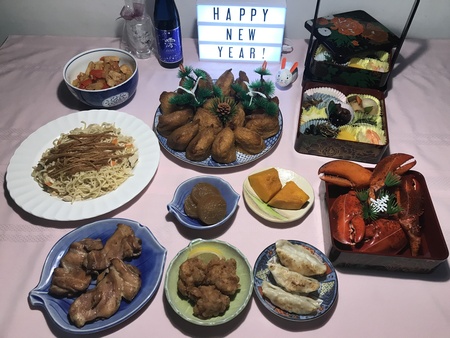When Lunar New Year celebrations are underway, I often get asked if I celebrate Lunar New Year. I let people know that I celebrate Japanese Canadian New Year on January 1. Japanese follow the Gregorian calendar, a solar calendar. However, this does not stop me from learning about and celebrating different cultures.
One Japanese New Year’s tradition is the animal zodiac which is also followed by other Asian communities. 2024 is the year of the dragon according to the Japanese zodiac (junishi). There are 12 animals which are rotated annually. First is rat, followed by ox, tiger, rabbit, dragon, snake, horse, sheep, monkey, rooster, dog, and ending with wild boar. One legend is that there was a race to determine which animals would represent the zodiac. The order of those in the race is their order in the zodiac. At New Year’s my family would usually have the annual animal in the form of a tabletop decoration or something more practical such as a toothpick holder.
As a Yonsei, fourth generation Japanese Canadian, with multi-ethnic cousins, aunts, and uncles, I was fortunate to enjoy different traditions and some of the best food. For example, opening presents with my Canadian-Italian-Japanese cousins at midnight on Christmas Eve and feasting on Panettone, a sweet fruit bread, and pastries filled with cream. For my immediate family, it’s all about the turkey, stuffing, cranberry sauce, and side dishes on Christmas Day. On New Year’s Day, it’s all about Japanese food.
The preparation and activities start before January 1. Under the watchful eye of my mother, the house would be cleaned, and all the old year’s dust must be swept out. My mother, grandmother, and my ancestors before them, would prepare massive amounts of food, all sorts of special dishes so that we would not have to cook on the first three days of the New Year.

On New Year’s Eve, we eat noodles, toshikoshi, before midnight. The long noodles represent a long life. Usually, soba noodles are used. Soba noodles are made from buckwheat which is a hardy plant and represents strength and resilience. Also, it is said that the noodles are easily cut so it’s also a way of letting go of the hardship of the year.
My grandmother made noodles from scratch. She was a strong, patient woman, and tiny in stature. She would take her wooden rolling pin, a long cylinder of wood which seemed to be as long as she was tall and roll out a flattened ball of dough on the kitchen table. She never got tired as she worked the dough, and transformed the ball into a thin, large rectangle which covered the table. She would then fold the dough over and back and over, repeating the back and forth until she had a smaller, but long layered rectangle. Taking her large sharp knife, she would cut the dough into thin precise strips. She would gently unfold the strips and give them to me to spread out on white paper covering the dining room table. When there was no more space on the table, I would hang the strips of dough across the paper covered backs of the dining room chairs.
We finished making noodles, but we were not done. The broth had to be made and we needed to prepare the other ingredients that would go with the noodles. Grandma would grind fish to make her own kamaboko (fish cake). She also would get green onions from her garden and cut them finely and sprinkle them on top with strips of toasted nori (seaweed).
Presentation was also an important part of the process. We had special bowls for the soup. And special plates and bowls for everything she made. When I was younger, she and my mother would tell me which serving dish to use, and now, it seems so natural to me to consider the combination of colour, shape, and material when choosing a serving dish.
The osechi-ryori are special food presented in stacked lacquer boxes that welcome all the good fortune on New Year’s Day.

When I was little, I remember my mom and my grandmother telling me I have to eat all the special food so it will bring me luck and good health. Special food included kuromame, sweetened black beans that symbolize good health because of the similarity of the words. Nishime has gobo (burdock root), carrots, lotus root (renkon) and taro (satoimo). Gobo has long carrot like roots and represents stability and strength. The many holes in lotus root show an unimpeded view of the future. Taro has many roots symbolizing many offspring.
Ebi are cooked prawns, with the curved back and whiskers resembling an elderly person, representing long life. Tazukuri are dried baby anchovies coated in soy sauce symbolizing a bountiful harvest. Kombu, cooked kelp, means happiness and joy. Ikura (salmon roe) like gleaming red jewels symbolize fertility. Kinpira is a mixture of gobo and carrot. Kamaboko (fish cake) slices are usually red and white which are festive colours, and the shape resembles the first sunrise of the new year.
Besides the osechi-ryori we would also have other Japanese dishes such as Cumberland (where my grandmother lived before the forced uprooting in 1942) chow mein, salmon teriyaki, chicken karaage, gyoza, sushi and sweets.
One of my favourite sweets is mochi which is pounded sweet rice, soft and smooth, filled with anko (sweet red bean paste).
My family’s favourite sushi is inari sushi, seasoned rice in fried tofu pouches. My grandmother made it for everyone – it was her love in the form of food. Even my cousins who were picky eaters loved grandma’s “bag sushi.” When she died, my mother took on the role of making it. Now, that she is gone, I make it. My cousins still call it bag sushi even though I try to correct them.
We ate the noodles on New Year’s Eve and special foods on New Year’s Day for luck in the year ahead. I never thought too much about the luck, but we did have the good fortune of a warm, safe home, delicious food, and the support of a caring family throughout the year. I do count myself lucky for the time I had with my grandmother and my mother, strong women survivors, and learning the lessons of tradition, culture, and love.
So many memories are attached to our food traditions. The link between family, food, and culture is not limited to Japanese Canadians, and has always fascinated me. I see the sharing of food and stories as a powerful way to connect people.
What are your food traditions and memories?
© 2024 Lorene Oikawa



